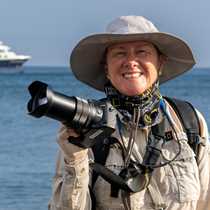Santa Cruz Island
Today began with an exploration of town. It was morning, and a fishing boat had just arrived at the fisherman’s wharf, so brown pelicans, lava gulls and sea lions were poised for action. The fishermen who work there know these individuals well, and keep them at bay when necessary, but also spoil them occasionally with tidbits. The situation creates a gray area for the implementation of Park rules about not disturbing wildlife and not feeding them either, but it certainly brings in the visitors and gives an opportunity for some extraordinary photographs.
On our way out of town there was a brief stop at a lava tube whose roof had collapsed many millennia ago, and peeking down inside, we glimpsed the striations of past lava flows in the interior. There was also a stop at the highland town of Bellavista for a mid-morning coffee break and sugar cane juice tasting. The cane press is completely constructed of wood, in beautiful condition, and produced some very tasty cane juice. Fresh-brewed coffee was next door, and combining the two was how coffee was sweetened in earlier times. Of course along with the coffee we just had to try the local chocolate-laced breads from the bakery next-door. An unexpected treat was finding the pods of Inga, locally called “guava,” but not what we know as guava in the English language. These pods can be opened and they are lined with black seeds covered by a sweet and fuzzy casing – delicious!
We finally arrived at our destination, Cerro Mesa, to discover there was a giant tortoise on the property not far away. These are very special tortoises, a small population living on the eastern side of the volcano, and the latest DNA results have shown a strong affinity with the population of tortoises from San Cristobal Island (tomorrow’s destination). The genetic research that has lately been published about Galápagos tortoises in general is turning the taxonomy of these reptiles topsy-turvey. In any case, the carapace of these tortoises is indented in the back…and we saw this in both the living individual and the old, bleached, shell found by the owners and tried on for size by our guests.
This property is unusual in another way as well, for it lies on the edge of the moist zone and the dry, rain-shadow side of the island. As a consequence, both Scalesia (the dominant plant species of this zone known for its wetness) and Opuntia prickly-pear cacti (the dominant species of the arid zone) can be found side-by-side at 1,400 feet elevation.
The trip down from Cerro Mesa to the restaurant for lunch is about five miles, and quite a few chose to do this by mountain bike. We all met for lunch (no one over-shot the restaurant turn-off), and soon enough were heading back down the volcano towards the Tortoise Rearing Center managed by the Galápagos National Park with consultation and advice given by the Charles Darwin Foundation. Big ones, little ones, various shell shapes from various islands, mating behavior…a bit of everything was seen during the afternoon.
By the time everyone had made it back on board, the town of Puerto Ayora was considerably richer from the purchases, and camera memory cards were considerably fuller than before. Tired, but content, enough energy was found to enjoy the talented musicians who came on board after dinner…even a bit of dancing was had! This was a very complete day…and another is on its way!




